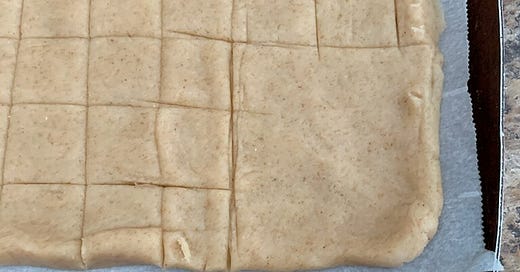In this post about the spiritual aspects of the Lord’s Supper I mentioned something very practical—a recipe for unleavened communion bread. Here is that recipe:
Communion Bread Recipe
¾ cup whole wheat flour and 1 ¾ cup white flour
2 tablespoons of sugar
1 teaspoon of baking powder
½ teaspoon of salt
1 cup of butter (you can substitute shortening or oil, but it doesn’t taste as good)
½ cup of milk (I just add milk slowly until it feels right. Sometimes when I do a full ½ cup it is too runny and gooey)
Mix dry ingredients together. Cut in the butter. Mix in the milk. Roll out to ¼ in. thick on a large cookie sheet. Before baking cut halfway through the thickness into 11/16 inch squares. (This is the tricky part because you don’t want to cut all the way through. You want to keep it as a whole.) Bake at 400 for 14-15 minutes. You can take the temp down and extend the minutes. Adjust to fit your oven. While it is hot cut into big square sections so that each section fits on the plate.
“Above is the original recipe, I have made some slight adjustments in technique:'
I roll the dough on a piece of parchment paper to a 11x14 inch rectangle, then slide it onto a large cookie sheet and then lightly score it with a pizza cutter into ¾ inch squares. I bake it for 15 minutes at the recommended temperature of 400 degrees, then I take it out of the oven and remove the outside squares because sometimes the inner rows are not thoroughly cooked through and then return the partially ones back to the oven for one or two more minutes. One important item to remember is that if you want a piece of the bread for breaking at the Lord’s Supper, you should remove a 3x3 square or a 4x4 square piece before you break them all apart. This freezes well, so you could divide it in half and freeze the other half for the following month if this is more than you can use in one Lord’s Day.’’
What should we think about at the table?
At my church, the Lord’s Supper elements are distributed (the bread then the wine), held, and then the congregants partake in unison to demonstrate the communal nature of the meal. I like this way of doing it though it’s certainly not the only way. The




Dozens of recipe sites show that Scottish shortbread, Dutch butter cookies and American sugar cookies are virtually the same recipe. The recipes for unleavened bread on all these sites are variations of flour, oil, and salt. American Presbyterians seem to be the only people in the world who think shortbread is unleavened bread. Even Wikipedia and Google searches note the difference. If, as you say, you are NOT attempting to replicate unleavened bread as defined in Scripture, then why call it that? It is misleading. The tradition of using shortbread started in 2 outposts in Scotland in the late 18th century and was then banned in the early 20th century. I wonder why it was banned -- maybe something to do with Article 35 of the Belgic Confession?
Actually, this is not unleavened bread. Scripture defines it as grain (flour), oil and salt. No sweetening agents were allowed at all, possibly because of fermentation, but also it was a pagan practice to offer sweet cakes to goddesses which the Israelites did from the time they were in Egypt to the time of Jeremiah. This recipe not only has a leavening agent in it (baking powder), but it also has sugar and butter. In the late 19th and early 20th century, the Assembly in Scotland banned the use of this shortbread sugar cookie for use in communion in Scotland on the grounds that it was not bread. That did not stop American Evangelicals from using it though. In Scotland, no one would call this unleavened bread. It is marketed as as shortbread, a dessert cookie.